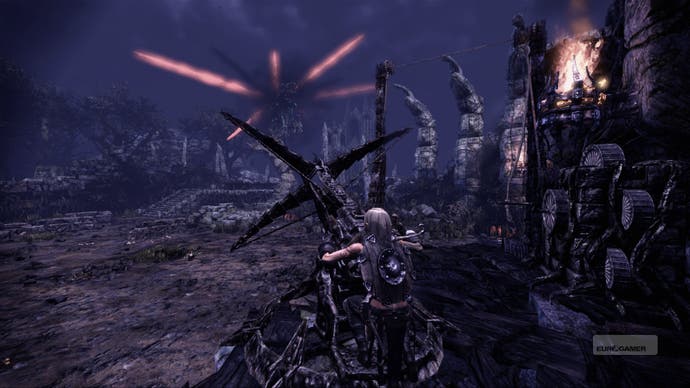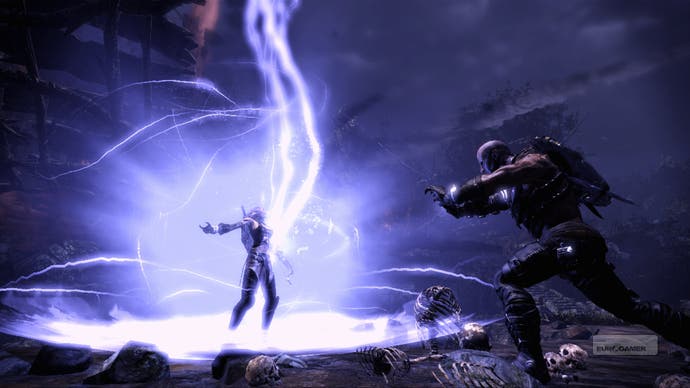Hunted: The Demon's Forge
inXile comes home.
It's not that long since we last (and first) saw Hunted: The Demon's Forge. When we were introduced to the game then, studio founder Brian Fargo announced his intention to revive the classic fantasy dungeon crawl; his colleagues Matt Findley and Maxx Kaufman showed us the muscular third-person action game, designed around two-player co-op, that they were marrying it with.
But we didn't see the union of the two, not quite. The demo showed off the co-op interplay between melee warrior Caddoc and elven ranger Elara; the simple character advancement in which new skills are bought for crystals; the way the two characters can use magic offensively or to "battle charge" each other with magical buffs; and the intense combat with its familiar cover system and shields that are destroyed with use. Mostly, it showed us a linear, breathless charge from set-piece to set-piece. Hunted's simple but unusual combination of two gaming staples - the dark fantasy milieu and the cinematic action game - grabbed the easy headlines.
The roots Fargo had been so keen to point out were obscured, although it was easy enough to take the game's credentials as a dungeon crawl on trust, given the Interplay veterans standing in the room. But Findley and Kaufman are back with a new demo intended to correct any possible misconceptions. They do so simply and cleverly, by showing us half an hour of live co-op gameplay during which they make little actual progress through the game's storyline.

Exploration, distraction, sub-questing, riddles and loot. Here on the screen are the aspects of Hunted we didn't really see last time, the parts of its make-up it doesn't share with the Uncharteds and Gears it superficially appears to ape. Every good dungeon crawl has to feature rewarding excursions off the beaten path, and Hunted is no different.
It is less dingy than most, however. When Elara and Caddoc make their way past a satanic altar with its regulation corpse-pile, it's set by a picturesque waterfall. For the first half of the demo, they're exploring ruins in the open air, crumbling sandstone exposed to the elements and overrun with vegetation, tropical birdsong echoing around.
The sunshine doesn't last, but that's only because Elara inadvisably touches a green crystal skull on a pedestal that might as well be labelled "press here for punishment of greed, hubris and impetuosity". The skies darken and glower, the earth shakes, pillars crumble and the pair find themselves in a tight, interesting combination of combat set-piece and puzzle.

Two giant gargoyles high on either side of a clearing are summoning skeletal warriors. The skeletons are fairly easily dispatched, but they keep coming, and a tougher armoured variant starts hammering our heroes from an inaccessible ballista. Caddoc gives Elara a "battle charge" of lightning magic, enhancing her shots enough to take care of the bombardier; he then needs to keep the skeletons off her back while she shoots ropes to bring down a walkway that grants access to the ballista, which can then be used to destroy the gargoyles and stem the undead flood.
Kaufman and Findley talk a little to co-ordinate the scrap - Caddoc needs to be revived from death at one point, which can be done by lobbing a potion from range according to inXile's "co-op at a distance" mantra. But Caddoc and Elara are quite chatty too, with vocal cues ("Elara, shoot the ropes to bring down that walkway!") clearly directing the adventurers to the next stage of the fight.
It turns out this isn't an over-zealous, puzzle-ruining help system; the exclamations are actually triggered by one player spotting something in the environment and using a look command. It's a neat, disbelief-suspending communication tool. When the fight is done, a little banter between the leads lets you know who performed best.


.png?width=291&height=164&fit=crop&quality=80&format=jpg&auto=webp)




.jpg?width=291&height=164&fit=crop&quality=80&format=jpg&auto=webp)
